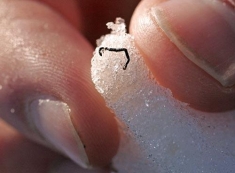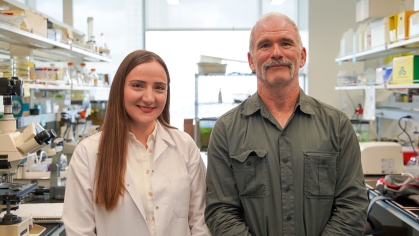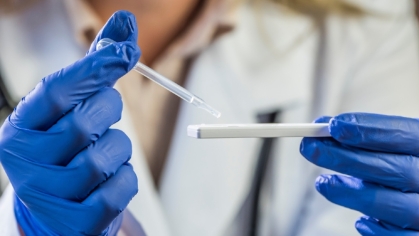Visiting scientist Tugba Avan came from Turkey to collaborate with Rutgers–Camden faculty on potential medical breakthroughs

Deep within the icy stillness of the glaciers and snowfields found across Alaska, British Columbia, and the Pacific Northwest lives a scientific marvel that could hold the key to life-saving breakthroughs in medicine and health: the Mesenchytras solifugus, more commonly known as the ice worm.
Close cousins of the earthworm, ice worms are small, black or dark brown in color, and rather unremarkable at first glance. However, their unique ability to thrive in below-freezing temperatures inspired scientist Tugba Avan to travel more than 5,300 miles from her home in Turkey to the Rutgers University–Camden campus, where she hopes to unlock ice worms' cellular secrets.
“Daniel Shain's research here at Rutgers–Camden has shown that ice worms have unusually high levels of intracellular adenosine triphosphate (ATP), which serves as the primary energy source for all living cells,” Avan said. “Additionally, his research has shown that their levels of ATP increase as temperatures decrease, a notable contrast to other organisms.”
Avan is a medical doctor and assistant professor in the Department of Medical Microbiology at Ahi Evran University in Kirsehir, Turkey, where she focuses on the relationship between organisms and disease. In 2022, she attended the Ahi Evran International Medical and Health Sciences Congress, where Shain was presenting his work on ice worms. She realized a collaboration with Shain would allow her to build upon her existing knowledge and expand her research beyond the clinical samples she worked with in Turkey. But arranging long-term travel to the United States would not be easy.
Undeterred by the distance, Avan applied for and received a prestigious fellowship from Turkey’s leading research agency and arrived to New Jersey in early 2024. She will spend a year at Rutgers–Camden, furthering her research and collaborating with Shain and his team.

“I was intrigued by her proposal and welcomed the chance to work together,” Shain said. “It presents a genuine opportunity to advance what we’ve come to know about ice worms and the differences in their energetics.”
Shain and his team have discovered that ice worms can generate extraordinary amounts of energy because they likely "stole" a specific chain of DNA from cold-hearty bacteria they had eaten, which altered their genetic and mitochondrial makeup as they evolved.
“By transferring this adaptation into lab-generated bacterial cells, we hope to increase the stress tolerance in a variety of cell types by enhancing energy production," Shain said. "A successful result would have various applications in health care and commercially."
Avan agrees the potential impact could be significant.
“Many people suffer from mitochondrial dysfunction, commonly caused by mutations in the same protein that gives ice worms increased energy," Avan said. "A greater understanding of this adaptation could lead to therapeutic treatments for mitochondrial disease and would support similar research in the future.”



